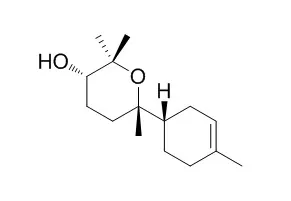| In vitro: |
| Arch Toxicol. 2010 Jan;84(1):45-52. | | Bisabololoxide A, one of the main constituents in German chamomile extract, induces apoptosis in rat thymocytes.[Pubmed: 19834689 ] | German chamomile (Matricaria recutita L.), one of the popular ingredients in herbal teas, has been traditionally used for medicinal purposes. Bisabolol oxide A (BSBO) is one of the main constituents in this herb. BSBO is supposed to be principle in some bioactivities of German chamomile such as anti-inflammatory, gastrointestinal, and antipruritic actions. Although the use of German chamomile has spread, the information related to toxicity of BSBO is very limited.
METHODS AND RESULTS:
In present study, the cytotoxic effect of micromolar BSBO was cytometrically examined on rat thymocytes by using appropriate fluorescent dyes. When the cells were incubated with BSBO for 24 h, BSBO at concentrations of 30 microM or more significantly increased populations of dead cells, shrunken cells, and cells with phosphatidylserine exposed on membrane surface. Both cell shrinkage and externalization of membrane phosphatidylserine are general features in an early stage of apoptosis. In addition, BSBO significantly increased population of cells containing hypodiploid DNA, and the increase was completely attenuated by Z-VAD-FMK, a pan-inhibitor for caspases, indicating an involvement of caspase activation.
CONCLUSIONS:
Thus, it is likely that the type of cell death induced by BSBO is apoptosis. The significant changes in cellular parameters of rat thymocytes by BSBO were not observed when the concentration was 10 microM or less. Furthermore, the short incubation (3 h) of cells even with 30-100 microM BSBO did not significantly affect the cells. Therefore, it may be suggested that BSBO is practically safe when German chamomile is conventionally used. | | Phytomedicine. 2011 Mar 15;18(5):362-5. | | Cytotoxic action of bisabololoxide A of German chamomile on human leukemia K562 cells in combination with 5-fluorouracil[Pubmed: 20863677 ] | German chamomile (Matricaria recutita L.) is a popular ingredient in herbal teas. In previous study, micromolar bisabololoxide A, one of main constituents in German chamomile, exerted cytotoxic action on rat thymocyte, a normal non-proliferative cell. This result prompted us to study the effect of bisabololoxide A on proliferative cancer cells and to seek the possibility of its use with 5-fluorouracil, an anticancer agent.
METHODS AND RESULTS:
In this study, the effect of micromolar Bisabolol oxide A on human leukemia K562 cells was cytometrically examined. Although the incubation of K562 cells with 10 μM Bisabolol oxide A for 72h did not significantly increase the percentage populations of dead cells and shrunken cells, the inhibitory action on the growth was obviously observed. It was not the case for the concentrations of less than 5 μM. The threshold concentration of Bisabolol oxide A to exert the cytotoxic action on K562 cells was ascertained to be 5-10 μM. Bisabolol oxide A at 5-10 μM did not exert cytotoxic action on normal non-proliferative cells (rat thymocytes) in our previous study. Since the antiproliferative action of micromolar Bisabolol oxide A on cancerous cells was expected to be beneficial to cancer treatment, the modification of antiproliferative action of 5-fluorouracil (3-30 μM) by Bisabolol oxide A was studied. The combination of 5-fluorouracil and bisabolol oxide further inhibited the growth of K562 cells although the additive inhibition of growth by Bisabolol oxide A became smaller as the concentration of 5-fluorouracil increased.
CONCLUSIONS:
Therefore, it is suggested that the simultaneous application of German chamomile containing Bisabolol oxide A may reduce the dose of 5-fluorouracil. |
|






 Cell. 2018 Jan 11;172(1-2):249-261.e12. doi: 10.1016/j.cell.2017.12.019.IF=36.216(2019)
Cell. 2018 Jan 11;172(1-2):249-261.e12. doi: 10.1016/j.cell.2017.12.019.IF=36.216(2019) Cell Metab. 2020 Mar 3;31(3):534-548.e5. doi: 10.1016/j.cmet.2020.01.002.IF=22.415(2019)
Cell Metab. 2020 Mar 3;31(3):534-548.e5. doi: 10.1016/j.cmet.2020.01.002.IF=22.415(2019) Mol Cell. 2017 Nov 16;68(4):673-685.e6. doi: 10.1016/j.molcel.2017.10.022.IF=14.548(2019)
Mol Cell. 2017 Nov 16;68(4):673-685.e6. doi: 10.1016/j.molcel.2017.10.022.IF=14.548(2019)